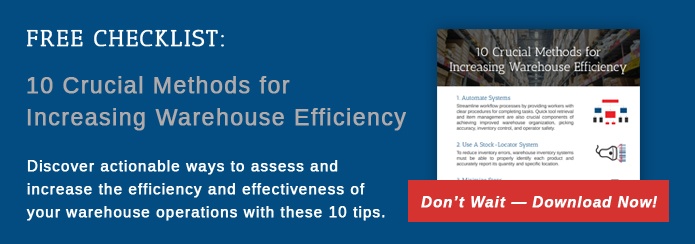 Complacency is an enemy of warehouse efficiency. It is easy to let your warehouse operations and layout remain the same and just adjust your processes to accommodate for existing issues. After all, there are many other things to keep you busy on a given day, and everything seems to work out okay in the long run, so why mess with it?
Complacency is an enemy of warehouse efficiency. It is easy to let your warehouse operations and layout remain the same and just adjust your processes to accommodate for existing issues. After all, there are many other things to keep you busy on a given day, and everything seems to work out okay in the long run, so why mess with it?
But the reality is, the longer you wait to evaluate your warehouse and address those issues, the more ground you are losing in regards to efficiency... and that translates to lost man hours, higher costs, and more mistakes.
What Should You Be Looking For?
Often the hesitation to taking the initiative to evaluate warehouse efficiency and performance is the realization that things will change in order to correct the issues that are uncovered. Here are some questions to ask during the evaluation process and some of the potential solutions to correcting the issues discovered:
- How efficient is your warehouse floor layout?
If your workers are deadheading to far corners of the warehouse on a regular basis, you should evaluate your options regarding rearranging the locations of products or shelves. - How accurate is your inventory at any given moment?
If your numbers are already off the minute you complete your annual inventory, you need to consider alternative options for keeping your inventory up to date. Managing inventory with warehouse management software is a great solution. - How long does it take for an average worker to pick an average order on a normal day?
If you cannot answer this question with some level of certainty, your reporting and metrics are completely inadequate or non-existent. Incorporating a Warehouse Management System (WMS) that offers real-time analytics and analysis is the most efficient way to get these answers. By taking action with the data provided, you can tighten up performance measures and improve the quality of work being performed. - How many errors occur per day/week/month/year?
If your honest answer to this question makes you uncomfortable, it's past the time for you to take the necessary steps to improve your workers' accuracy or do discover why these errors are happening. Sometimes the solution is additional training for employees, but sometimes it may come down to identifying which worker is responsible for the bulk of the issues – information that can be gleaned from WMS data. - When was the last time you did a walkthrough of your warehouse and simply observed its normal operations?
If you say, "it's been ages," or "never," there's no time like the present to get up and go take a walk. Solutions don't just magically appear. You need to be aware of what is happening in the warehouse before you can even think about improving it. - When was the last time you talked with your workers about problems and opportunities on the floor?
Once again, if your answer is, "never," or, "a long time ago," it is time to have a face-to-face with your employees. It is often difficult to get a full picture of warehouse operations from the outside. By engaging with your people and giving them an opportunity to provide feedback and even potential solutions to ongoing issues, you not only gain ground operationally, but also relationally, within your warehouse.
What Should You Do Now?
Once the necessary adjustments have been made, it is important to maintain good habits to ensure that you stay on top of the process. This usually involves taking certain actions on a regular, ongoing basis.
- Gather and assess data constantly.
This is where a good WMS comes in handy. It can gather all the data you need to assess your warehouse efficiency, work quality, error rates, pick times, and other key metrics to help you see what is actually going on. - Talk to your people.
Your managers can tell you about what they see and what they identify as areas that need improvement. Your workers can give you feedback on what is working well and what is not. - Take action and make improvements when necessary.
All of your WMS and interpersonal data-gathering should give you a list of action items that you can initiate in order to improve your warehouse efficiency. Don't just let that list grow. Take action where you can, as often as you can. Be sure to benchmark and measure your improvements so that you can celebrate how far you've come.
Ultimately, if your answer to the question "How often do you evaluate your warehouse?" is anything less than, "Constantly," you have some work to do.



